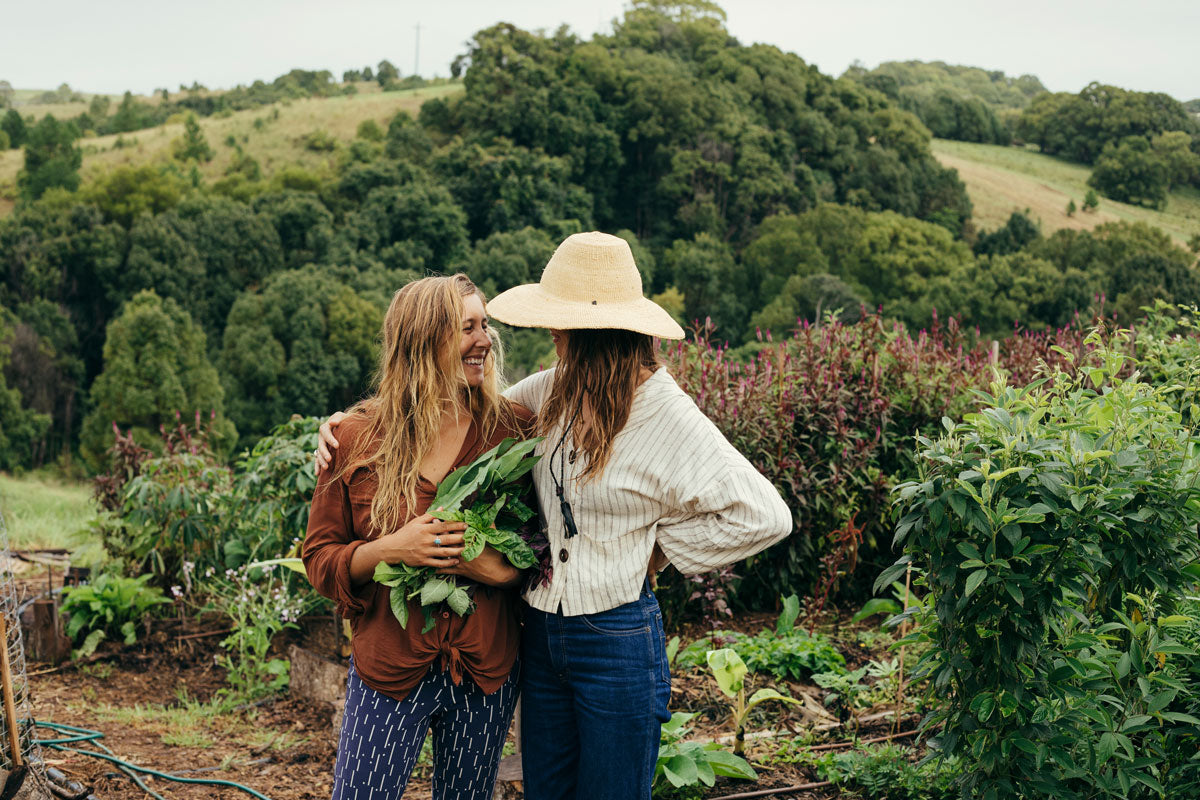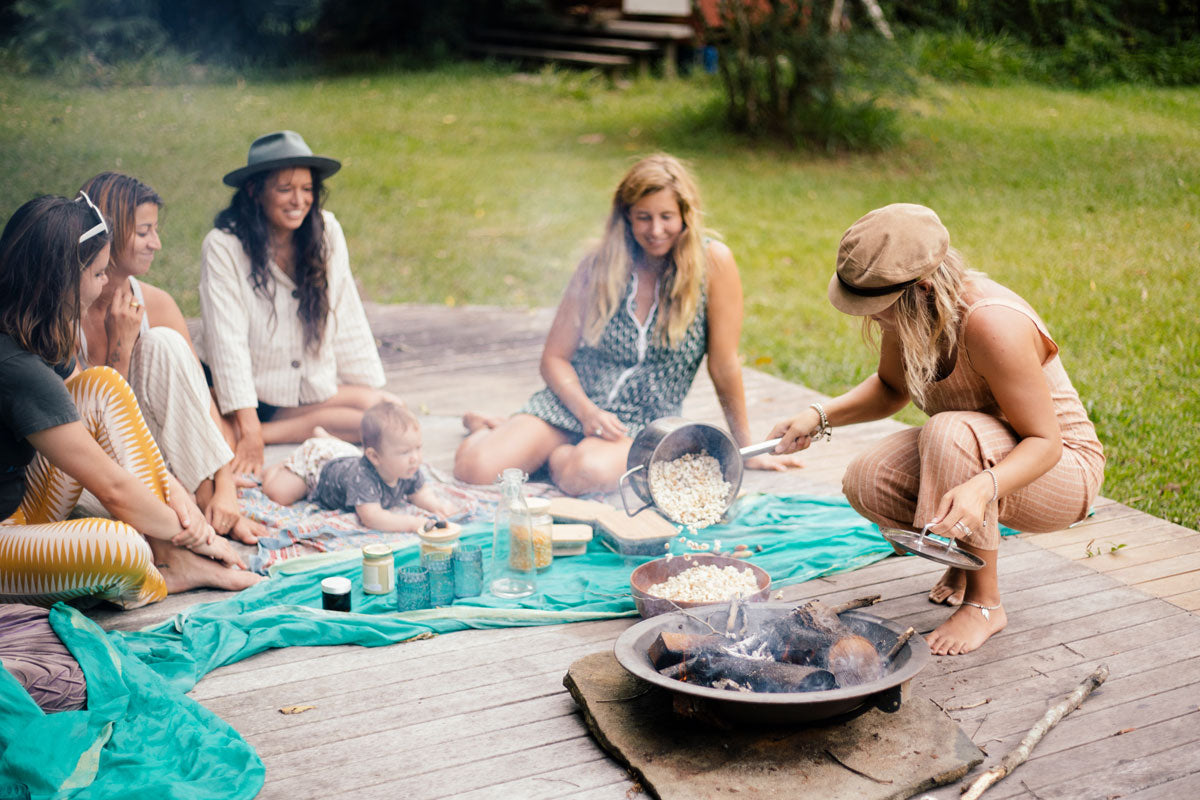Words by Lauren L. Hill. Photos by Luki O'Keefe.
‘A wise gardener grows soil, not food’
Kobi Bloom is a regenerative gardener; she’s passionate about feeding her soil as equally as it feeds her. Kobi leads foraging workshops for all ages, in pursuit of connecting us to the places we inhabit—and the everyday magic of seeds, soil, sunlight and water popping up all around us.
Kobi continues a long lineage of wise women who maintain that plants are our most powerful medicine. Her most recent project, 96 Bangalow, focuses on “zero emissions, a closed waste loop, land regeneration, and organic food systems.” In other words, it’s a regenerative farm bursting with well-loved fruits and veggies, and plenty of medicinal weeds, too. We caught up with Kobi on the farm, between squalls of the season’s first soaking of the Earth after a long, hot Australian summer.

Kobi wears the Sol Jacket, made out of organic cotton and hemp.
Lauren: We’re walking and come across a plume of spilling red clover, one of the many weeds that Kobi nourishes alongside her organic farm fare….
Kobi: Red clover is this leguminous, beautiful, tumbling herb. The flowering tops can be eaten. The top leaves and the flowers can be dried and made into a tea or a really long infusion. When you consume it, there are isoflavones in the plant and in the flower that fill in hormonal receptor sites. They’re basically like a phytoestrogen that protects your reproductive organs, your breasts, ovaries and uterus from free radical damage that exist in pesticides on food, pollution, and plastics in our environment.
It’s always been a really important herb for women’s health across all of Europe and North America. It’s growing wild in those places.
Luki: I feel like I’ve seen that growing through the cement at home in California…
Kobi: And you would, for sure. It’s a really hardy plant.

Lauren: Kobi, can you tell us about Weed Theory?
Kobi: Weeds are the protectors of the soil and the ecology under the soil. Humans come along and neuter the soil, basically. And weeds come along and decide to cover up the soil. Weed trees, like the Camphor Laurel trees all around here, they were like a band-aid for the land after all of the loggers came and left all of this bare, raw soil and ran hard hooved animals on it.
Even though most people think of Camphor trees as invasive here, they have also worked to protect the water systems and waterways; a band-aid until the land can regenerate. They’re mining up all different kind of minerals and trace elements that have been sucked dry from the top of the land. They’re reaching deeper and transmuting those minerals and bringing them up to the surface, and dropping leaves to nourish the topsoil again. It’s like this beautiful cycle of bringing nutrients up from the roots and dropping them onto the surface so other plants on the surface of the soil can begin to regenerate again.
Lauren: How did we get to this place where weeds are so demonized in our yards and gardens?
Kobi: Let’s take something like a dandelion—it’s known as a weed. People take it out of their lawns. But dandelion has this amazing taproot which has a different biology and is the key to unlocking certain minerals and nutrients in the soil that other plants can’t unlock. So they’re drawing things up to the surface and into their foliage, and then dropping their foliage to nourish the soil in ways that other plants can’t. So when you see a particular weed in a certain part of your garden, you can literally tell what’s deficient in the soil. Where dandelions are, there might be a zinc deficiency or an iodine deficiency. You can tell the acidity or alkalinity based on certain weeds. Weeds are the medicine for the soil. It’s crazy that we kill them.
So here, in a regenerative treatment of the land, we don’t pull weeds out. We cut them off at the top of the roots, so the roots are still in the soil. The roots can keep the structure of the soil. They can create pathways for water to run down and then the roots eventually rot down into the soil and create bacterial pathways and mycelial pathways. And that’s part of the regeneration of the land. When you cut off a weed and drop the foliage onto the soil, it’s soaking back into the soil, instead of taking that medicine away to another place.

Lauren: So is that one of the primary differences between organic agriculture and regenerative agriculture?
Kobi: Yes, definitely. Organic agriculture—generally speaking, and especially on a commercial scale—is basically just not putting chemicals on the soil or plants. Regenerative is about making the soil continuously better, improving it all the time, and not just taking from it but working together. The land and humans need each other.
Luki: What do you bring into your soil at this point?
Kobi: Because this soil was so rough and raw when we came, we’ve been bringing in mushroom compost, a little bit of natural lime, composted chicken manure or cow manure, and worm castings from our worm farm. Another thing we do that’s kind of like a homeopathic treatment for the soil is that we take the weeds and put them in a bucket—sometimes people add urine because it’s acidic and has bacteria in it that helps to break things down—with water. You dilute that 1:10 or even less and then water it back over the soil. After a little while, because those minerals have been fermented and you’re reapplying those minerals to the soil, you’re regenerating the soil. Those weeds don’t need to grow anymore.

Luki: I’ve never thought of weeds that way…
Kobi: It’s amazing that we all aren’t taught this stuff. Most weeds are incredible medicine for humans, as well. Plants that Western society considers to be weeds, like dandelion, are rich in iron, magnesium, zinc, and calcium. It’s an incredible tonic for women’s reproductive system and to cleanse our blood. That taproot on the dandelion, it’s almost like a carrot root, goes so deep and has the ability to draw up so much goodness. There’s something like 70 minerals in the soil that are nutritious for us, and we get only a small number of those through conventional farming. Things like dandelion that’s growing in wild places, that’s been challenged, that is a strong, hardy plant with its own sense of place and immunity. They’re often really compromised by drought, for example, especially here or flood.
Luki: They’re survivors…
Kobi: Yeah, they’re survivors and I think they can create that mechanism in the human body when we eat them.
Here’s another weed that a lot of people want to take out of their lawn: Gota Kola. It’s amazing for epithelial regeneration for your hair, skin, eyes and all your mucus membranes can really benefit from it, and also our brain. It’s one of those incredible brain tonics that help with cognition. It’s an incredible food. And it tastes like medicine – it’s bitter and intense.

Lauren: Isn’t that interesting that as our palates have grown more and more accustomed to the sweeter foods that industrialized agriculture produces? As we’ve culinarily moved further from the bitter weeds that probably sustained our ancestors several generations ago, we’ve also moved away from the foods that nourish us most deeply. I think about this a lot when I’m feeding my 20-month-old son, how we expect babies to only have a palette for sweet, but that it isn’t necessarily true if we eat a diet rich in bitter and sour foods.
Luki: What we’ve been fed with Western diets so high in sugar kind of makes our palettes biased against the good stuff… the bitters.
Kobi: Absolutely. It’s like white people coming to Australia and handing out tobacco and white flour to native people. That stuff changes your brain completely. And we’ve seen what happens when you switch from a wild, foraged diet to a Western, white bread diet.
Our liver is what responds most to those bitter flavours and nutrients. And our liver is what detoxifies our body; it’s one of our biggest processors of toxins in the body. To not be nourishing that organ in our body—just because of taste preference— that’s just not worth it. It’s really important to get used to it to nourish those parts of your body.
Sometimes it takes a lot of explaining to adults about the connection between humans and plants and the soil. But for kids, you just need to give them a little reminder and they’re just straight back into that wonderland and total love and connection with all of it. I was taking kids over to the community gardens and doing weed foraging workshops with the kids.
The coolest thing was that they were the most excited to taste the bitterest weeds that I could find. I’d be like ‘guys, it’s totally fine if you don’t like it, it’s not for everyone’ and they’d be like ‘No! We wanna taste it!’ and lining up and getting so excited. These were kids between the ages of 7-9, and they were just straight back in there, writing poems about their experiences with the plants. Their teachers said that they’d never seen the kids so engaged. They just naturally get it.









1 comment
Cosi Krzanich
Great article thank you. Do you have a contact for Kobi’s workshops? Google not forthcoming. Cheers, Cosi
Great article thank you. Do you have a contact for Kobi’s workshops? Google not forthcoming. Cheers, Cosi